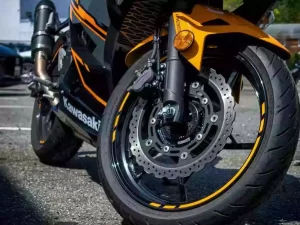Key Takeaways
- Seat covers protect seats, add comfort, and extend lifespan.
- Materials like leather, mesh, neoprene, and rubber each serve different needs.
- A good cover boosts style and safety, especially in wet conditions.
- Covers are far cheaper than replacing the whole seat.
You might not think much about what you’re sitting on, until you’re 50 miles into a ride, shifting around like you’re auditioning for a rodeo. The motorcycle seat cover is more than just decoration. It’s armor against the elements, a cushion for your backside, and, honestly, a little style statement.
For your daily commuting or long trips, the right seat cover can mean the difference between “epic ride” and “never again.”
Let’s break down the types of motorcycle seat covers, compare materials, and figure out which one fits your bike and your behind best.
Why Motorcycle Seat Covers Matter
- Comfort: Long rides punish your lower back and thighs. A good cover adds padding or airflow where you need it.
- Protection: Rain, UV rays, and dust all degrade leather and foam. Covers extend seat life.
- Style: From classic leather to bold patterns, seat covers let you customize your bike’s look.
Types of Motorcycle Seat Covers

- Leather Seat Covers
Leather has long been a classic choice for motorcycle seat covers. Genuine leather seat covers are crafted from high-quality animal hides, such as cowhide or buffalo hide. They offer a combination of elegance, durability, and comfort that has made them a staple in the motorcycle industry.
Leather allows air to pass through, reducing the chances of heat buildup and sweat accumulation during long rides. This feature enhances overall comfort and helps regulate body temperature, especially in warmer climates.
- Pros: Leather has a timeless look, molds to your body over time, high durability.
- Cons: Expensive, hates water, requires regular maintenance.
- Best for: Cruiser riders and anyone who wants that classic biker aesthetic.
- Synthetic Leather (Vinyl, PU)
These materials, such as vinyl or synthetic leather, offer several advantages that make them an attractive alternative for motorcycle seat covers.
They can be engineered to be breathable, UV resistant, and water-resistant, providing riders with enhanced comfort and protection. These materials often offer improved durability and resistance to wear and tear compared to natural leather.
Synthetic seat covers are also available in a wide variety of colors, textures, and patterns, allowing riders to customize the look of their motorcycle according to their preferences. Additionally, they are often easier to clean and maintain than natural leather, requiring less specialized care.
- Pros: Cheaper than leather, weather-resistant, low maintenance.
- Cons: Can crack with age, less breathable.
- Best for: Riders who want leather’s look without leather’s price tag.
- Mesh Fabric Covers
Mesh seat covers are designed with enhanced breathability in mind, prioritizing rider comfort in hot and humid conditions. They typically feature perforations or mesh panels strategically placed to promote better airflow and ventilation.
These covers are particularly beneficial for riders who frequently undertake long rides or live in regions with high temperatures. The improved ventilation helps to regulate body temperature and minimize the chances of excessive sweating, enhancing overall comfort during extended periods on the motorcycle.
- Pros: Excellent airflow (goodbye sweaty rides), quick-drying, affordable.
- Cons: Less plush, not as stylish.
- Best for: Commuters and hot-weather riders.
- Neoprene Covers
These seat covers are designed to protect the underlying foam padding and maintain the seat’s integrity even when exposed to moisture or wet conditions. They are made from materials that repel water, preventing it from seeping through and causing damage.
The water-resistant properties help to repel moisture, preventing it from being absorbed into the seat’s foam padding. This reduces the risk of mold, mildew, and deterioration caused by prolonged exposure to water.
- Pros: Waterproof, flexible, durable.
- Cons: Can feel sticky in heat, limited style options.
- Best for: Riders who brave rain, mud, and unpredictable weather.
- Rubberized / All-Weather Covers
Rubberized material is a popular choice for motorcycle seat covers due to its unique properties that provide both grip and waterproof protection. It’s typically made from a blend of rubber and fabric, resulting in a durable and versatile seat cover option.
One of the main advantages of rubberized material is its exceptional grip. This feature is particularly beneficial for riders who engage in aggressive or off-road riding. The rubberized surface creates friction between the rider’s gear and the seat, reducing the chances of slipping or sliding during maneuvers.
- Pros: Extremely durable, no-nonsense waterproofing, resistant to UV.
- Cons: Not breathable, minimal padding.
- Best for: Utility and off-road bikes.
Motorcycle Seat Cover Material Comparison Table
| Material | Durability | Weather Resistance | Comfort | Maintenance | Price Range |
|---|---|---|---|---|---|
| Leather | High | Low (water damage) | High | High | $$$ |
| Synthetic Leather | Medium | Medium-High | Medium | Low | $$ |
| Mesh | Medium | Medium | Medium | Low | $ |
| Neoprene | High | High | Medium | Low | $$ |
| Rubberized | Very High | Very High | Low | Very Low | $–$$ |
How to Choose the Right Seat Cover
The first thing you have to think about is the climate. For hot, sweaty rides, mesh would be the right choice. Rainy? Neoprene is your best bet.
Comparing style vs utility is another important thing. Want your bike to turn heads? Choose leather or synthetic. But rubberized covers make more sense when you want pure function.
You should think about the budget too. There’s no need to overspend, just know what trade-offs you’re making.
Care and Maintenance Tips
- Leather: Clean with a damp cloth, condition monthly.
- Synthetic/Neoprene: Wipe down after rides, mild soap if dirty.
- Mesh: Shake out dust and rinse occasionally.
- Rubberized: Pretty much indestructible—just hose it down.
FAQs
Do I really need a motorcycle seat cover?
Yes. It protects your seat from cracking, fading, or soaking up rain, and adds comfort.
Is there a one-for-all type for all riders?
No. Touring riders may love leather, while city commuters prefer breathable mesh. Match the cover to your conditions.
Do universal seat covers fit every motorcycle?
They fit, but not always perfectly. For a seamless look, go with a cover designed for your bike model.
What’s the cheapest reliable motorcycle seat cover option?
Synthetic leather and mesh covers give solid protection without draining your wallet.
How long do a motorcycle seat cover last?
Leather (if maintained) can last years. Synthetic and mesh: 1–3 years on average. Rubberized: nearly indestructible.







